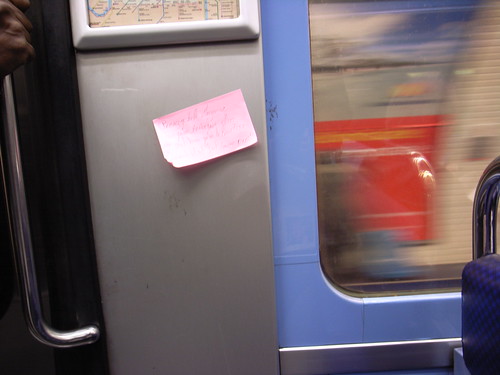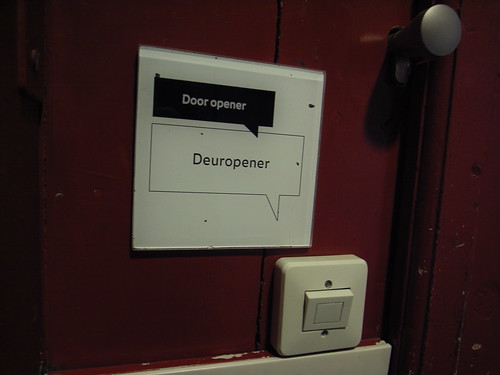Design flop reasons
Cris sent me this highly interesting paper that is spot on my Lift presentation: Why the overwhelming numbers of design flops? by Alice Rawsthorn. The article tries to list the reasons why design goes wrong and misses the point (besides reasons such as budget issues, deadline pressure and lack of talent). The list consists in:
- "Designing for other designers (...) ignoring entire consumer categories
- Change for change's sake
- They made us do it (...) one reason why cellphones are so infuriatingly difficult to use. The market is dominated by the cellular networks, which are understandably anxious to ensure that new phones are compatible with their technology. Unless the manufacturer complies, they refuse to sell the phone.
- Innovation for innovation's sake: why invent a new version of something that doesn't need to be improved?
- As long as it's green: sustainability is often used to excuse other deficiencies in desig
- Design by committee: The more ambitious - and expensive - the project, the more vulnerable its orchestrators seem to feel. That's why such projects end up being subjected to so many people's opinions, that they become as bland as a Hollywood blockbuster with a plot determined by repeated test screenings.
- Up, up and away: As corporate life expectancy shortens, ambitious executives have so little time to make their mark in particular roles that they meddle unnecessarily.
- But it worked for them/me-tooism, or copy the competition"
Why do I blog this? This is great material as it uncovers an interesting typology of failures with some underlying reasons.
Clive Grinyer on customer experience design
In this insightful blogpost Clive Grinyer, formerly designer a Orange, now at CISCO, reflects on his experience of customer experience design in the mobile industry. Some excerpts I enjoyed:
"In the conventional industrial product development process at that time, my design specification was handed to a mechanical engineer, with specialisms in a greater level of detail of material and process. It was a shock to then realise that the design was treated as merely a guide, where the engineer would take hold of the reigns and steer the object in whatever route made the production easier and more robust. (...) It is only in exceptional circumstances, such as at Apple, where their leadership, investment and strategy embraces those values, that you see the full impact. (...) In the mobile world I saw this repeated through a culture dominated by technology and decisions and assumptions made at every level that impacted badly on the end experience of the user. The situation was worse, in that I was not in the right order of process and "design" had already happened by the time I or my team had anything to do with it. This leads to technology developed without any thought of how it would be used, or 3rd party application providers incapable of customising or improving usability. (...) For the last months I have also struggled to understand what to say about the mobile. It seems so exciting that millions of people can be walking round with so much technology in their pocket but find so little use for it apart from speaking and texting. Open platforms, the promise of Android, ever more capable devices failed to unlock my cynicism in the ability of the mobile to deliver useful applications to normal people. And then the iPhone 3G did it."
His conclusion about "what to do" is basic: Talk about people (look at what people do), Discover the customer journey, Tell stories of how it could be, which are relevant aims in technological companies, and as he points out generally a surprise ("Hardly rocket science but revealing to most people still").
Why do I blog this?some good hints here to be re-used in my user experience course. The "talk about people" is a familiar trope to me. I often face the same situation, delivering a speech to technology people in a certain company (e.g. video-game industry, mobile software organization, design students) and I see the fascination towards the material I show them. Most of the time, documenting people's life is of great value to them as they smile and see how things work (or don't work) in a concrete way. However, it's then important to show them how this is valuable for the time being, for what they're achieving. Which is why what Grinyer describes about telling "stories of how it could be" is important. Perhaps I would add as a preliminary step "showing problem, issues, pain points and dreams", as a sort of material to inspire design.
Clothe pegs hack
 Along with duct tape, clothe pegs are perhaps one the most intriguing tool to modify the purpose of things in order to meet new objectives. The example above, encountered this afternoon in a french bathroom shows a striking example of a thoughtless act: how wooden clips can keep a tube of toothpaste properly squeezed.
Along with duct tape, clothe pegs are perhaps one the most intriguing tool to modify the purpose of things in order to meet new objectives. The example above, encountered this afternoon in a french bathroom shows a striking example of a thoughtless act: how wooden clips can keep a tube of toothpaste properly squeezed.
Why do I blog this? documenting thoughtless acts is always a pleasure at Pasta and Vinegar.
Bluetooth in your life?
About space and 'plek'
The distinction between "space" and "place" is commonly discussed in recent academic work in ubiquitous computing/HCI by researchers such as Paul Dourish. In a seminal paper form 1996, Harrison and Dourish express that "space is the opportunity; place is the understood reality." They raised the social construction of space by exploring how human actions are structured by the spatial organization of our environment. Unfortunately, as Dourish pointed out in his 2006 paper, this discussion lead to a misunderstanding: some people tended to exaggerate the distinction between spatial and social components. Interestingly enough, reading Assia Kraan's paper "To Act in Public through Geo-Annotation shared location", I ran across this interesting paragraph:
" It is important to make a distinction between space and plek. Anglo-Saxon theoreticians talk about space and place. The Dutch word plek (plural plekken) will be used here because the alternative ‘place’ does not express its meaning adequately. ‘Place’ is used, for instance, to refer to the physical space of a settlement, while plek refers to the meaning that a physical space has for somebody. A plek can be described as a complex ensemble of physical characteristics, cultural experiences, history and personal logic. Geographers target the navigational characteristics of plekken, but the computer scientists Paul Dourish and Steve Harrison emphasize an aesthetic quality. They recognize the function of plekken in a creative appropriation of the world and describe plekken as ‘developed sets of behaviour, rooted in our capacity to creatively appropriate aspects of the world, to organize them, and to use them for our own purposes’"
Why do I blog this? ruminating about different words and their cultural meaning is relevant here as it can express underlying dimensions.
Subway poetry
The more comfortable we become with being stupid
(via) Sometimes you don't expect titles like that in scientific press but "The importance of stupidity in scientific research" by Martin Schwartz in Journal of Cell Science is an intriguing read. Some excerpts I liked:
"we don't do a good enough job of teaching our students how to be productively stupid – that is, if we don't feel stupid it means we're not really trying. I'm not talking about `relative stupidity', in which the other students in the class actually read the material, think about it and ace the exam, whereas you don't. I'm also not talking about bright people who might be working in areas that don't match their talents.Science involves confronting our `absolute stupidity'. That kind of stupidity is an existential fact, inherent in our efforts to push our way into the unknown. Preliminary and thesis exams have the right idea when the faculty committee pushes until the student starts getting the answers wrong or gives up and says, `I don't know'. The point of the exam isn't to see if the student gets all the answers right. If they do, it's the faculty who failed the exam. The point is to identify the student's weaknesses, partly to see where they need to invest some effort and partly to see whether the student's knowledge fails at a sufficiently high level that they are ready to take on a research project.
Productive stupidity means being ignorant by choice. Focusing on important questions puts us in the awkward position of being ignorant. (...) The more comfortable we become with being stupid, the deeper we will wade into the unknown and the more likely we are to make big discoveries."
Why do I blog this? although I fully agree with the importance of absolute stupidity in scientific research, I think it's also an important attitude in design research. Some ideas to be explored later about this issue.
The red button interface
Possibly some weird work for computer case and cell phone designers: Parents should have a "red button" to disable a game they feel is inappropriate for their child, says the EP Internal Market Committee. So, the solution to avoid kids playing with games that are not suitable for them is... a red button. More information on the European Parliament website:
"Members of the committee are particularly worried about on-line games, which are easy to download onto a PC or a mobile phone, making parental control harder. Until PEGI on-line is up and running, the report proposes fitting consoles, computers or other game devices with a "red button" to give parents the chance to disable a game or control access at certain times."
Why do I blog this? A sort of red-button-determinism like this is quite hilarious. The idea of adding a new button that would comes out from the blue (like this) to prevent kids from inappropriate content sounds so passé that I can't help thinking about odd game devices (cell phones with gigantic buttons, desktop computers with switches) and, of course, the inherent problems that may happen!
Ubiquitous computing naming issue
There's an interesting discussion of the term "ubiquitous computing"by Mike Kuniavsky at Orange Cone. Mike basically explains the ambiguity of terms and deconstruct the very notion of ubicomp:
""Lately, I've been thinking about why "ubiquitous computing" has such problems as a name. When I talk about it, people either dismiss it as a far-future pipe-dream, or an Orwellian vision of panoptic control and dominance. I don't see it as either. I've never seen it as an end point, but as the name of a thing to examine and participate (...) Why don't others see it the same? I think it's because the term is fundamentally different because it has an implied infinity in it. Specifically, the word "ubiquitous" implies an end state, something to strive for, something that's the implicit goal of the whole project. That's of course not how most people in the industry look at it, but that's how outsiders see it (...) As a side effect, the infinity in the term means that it simultaneously describes a state that practitioners cannot possibly attain ("ubiquitous" is like "omniscient"--it's an absolute that is impossible to achieve) and an utopia that others can easily dismiss."
The problem is then that "Anything that purports to be a ubiquitous computing project can never be ubiquitous enough"! Then, what shall be done? As Mike points out, other terms such as "artificial intelligence" also had the same issues.
"Do we need to rename "ubicomp" something like "embedded computing product design," something that promises less so that it can deliver more? Maybe. I still like the implicit promise in the term and its historical roots, but I recognize that as long as it has an infinity in part of its term, there will always be misunderstandings"
Why do I blog this? preparing my Lift talk about failures I am interested in the difference between the imagined futures (endpoints such as ubiquitous computing, artificial intelligence or flying cars) and the reality as it is experienced by people (users?). Mike Kuniavsky makes interesting points about this issue here by looking at the how naming research domains/trends can be misleading.
Location-awareness and power management
The Potential for Location-Aware Power Management by Harle and Hopper is an interesting paper presented at Ubicomp 2002 that explore the use of location-awareness to dynamically optimise the energy consumption of an office. It basically shows how capturing workers' location can be helpful in a different domain than mobile social software or urban computing.
 (Figure taken from the paper: positions recorded for a particular user over four hours on a particular day across three floors)
(Figure taken from the paper: positions recorded for a particular user over four hours on a particular day across three floors)
The paper does not really describe an application, instead it demonstrates how an analysis of workers' location is relevant "to form a picture of how people work and what energy savings might reasonably be expected if we were able to prevent device ‘idling’". The authors link the discussion about "energy sinks" and workers' movement: is it possible to lower the power consumption of electrical devices when the users are not using them... by detecting whether the user is within range.
Of course, apart from the technological side, the main issue at stake in this kind of research vector is the following:
"we emphasise that any changes should not frustrate users. As an example, we informally asked a number of computer users in various commercial and non-commercial settings why they did not have their desktop machines automatically power down, suspend-to-disk, or go to sleep after a specified time. The majority cited the frustration of having to wait for the system to reach a usable state as a major contributing factor. We cannot afford, then, to assume that an aggressive power saving policy will necessarily lead to power savings since it may prove very unpopular and be circumvented. Instead workstations in the scheme discussed must be powered up and in a usable state before the user is physically upon them. "
Why do I blog this? home/office automation is an favorite topic of mine as it uncovers important issues regarding the loss of control from users. Of course, I find the use of location-awareness relevant in this sort of context and I am wondering about other way to deploy this sort of solution without frustrating users. The paper offers a good discussion concerning such issues.
RFID key mixed with and old key assemblage
 An intriguing mix of the bleeding-edge of recent times (seen at my hotel in Paris yesterday):
- this rfid key that you swipe on your door to enter your room
- the stability of the past: this old and commong keyring which is so heavy that you would not keep the rfid key in your pocket during a whole day: you must put it back at the hotel desk when you get out (delegation in design).
An intriguing mix of the bleeding-edge of recent times (seen at my hotel in Paris yesterday):
- this rfid key that you swipe on your door to enter your room
- the stability of the past: this old and commong keyring which is so heavy that you would not keep the rfid key in your pocket during a whole day: you must put it back at the hotel desk when you get out (delegation in design).
The flat, sober and white plastic key and the old copper keyring.
Lift09 tag cloud
A tag cloud that my colleague John Elbing generated using the information Lift participants entered to describe their interests.
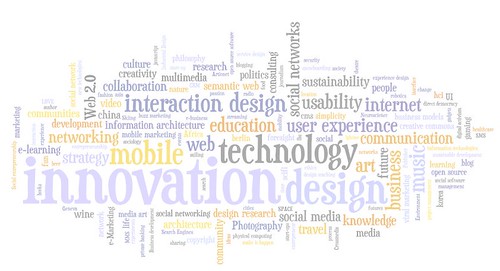
Why do i blog this? As a program organizer, it's interesting to see the profile and the interests of Lift attendants. Using this wordle is a good way to get an impression of what defines the conference. It's surely messy but there are some clear vectors: innovation is the main track with subthemes such as design/interaction design, technology and mobile. It's also important to see that there are less and less people interested in the Web ;)
The importance of blinking lights
This article in IEEE Spectrum made me think about this earlier post about what stays awake during the night. In the article, Robert W. Lucky describes the importance of blinking lights in hardware.
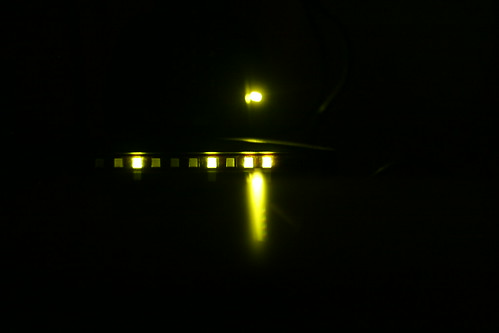
He takes the example of modem boxes which are full of indicator lights and explain that "people want blinking lights" as it shows whether the device is sick or in full swing.
"Often, you have no idea whether or not the gadget is working. When it doesn’t do something you expect it to do, you stare helplessly at the box. “Are you alive in there?” you ask plaintively. (...) Quite often there is no visible activity on my computer screen, but I see the hard-drive light blinking furiously. What is it doing? I wonder. At least the little light tells me that it is alive, though I worry about why it is so busy. At such times I often wish that there were a special key labeled “What are you doing?” I’ve always found the task manager rather useless for this purpose, and no human being could possibly interpret the gibberish that fills your screen following the dreaded “blue screen of death.” (...) Instead of an unintelligible binary dump, my imagined key would give a simple English explanation: “I’m busy at the moment reformatting your hard drive,” it might say"
And the author wonders about new design that does not include any blinking lights. The roar of air-conditioning is then the last sign of life inside the computer.
Why do I blog this? The aesthetic representation of blinking lights aside, these observation are interesting as they uncover people's practices with regards to technology. We have been used to get some concrete signs of activity in our artifacts. Small details like these lights are not so simple as we might think. The nice light ballet you can observe when glancing at your details are all but useless.
Removing the lights also make me think about all these studies about cars that make almost no noise, which are terribly dangerous in cities.
Speaking objects in Amsterdam
 Two curious encounters on my way from the Waag to the train station: the interesting use of speech bubbles in both cases, as if the designers of these elements wanted to convey the message that objects are close to have self-expression.
Two curious encounters on my way from the Waag to the train station: the interesting use of speech bubbles in both cases, as if the designers of these elements wanted to convey the message that objects are close to have self-expression.
This way to express objects' agency in our physical environment is certainly close to the blogject meme where "artifacts" and places would be more talkative in the near future. One can qualify the Internet of Things as "more than mere speech bubbles".
If as a citizen you can no longer fix your own car...
Finally got some time to meet-up and discuss with Rob van Kranenburg yesterday in Amsterdam at Waag. It's been a while that we only briefly exchanged during conferences and I wanted to know more about his work. It also immediately led me to read his recent book about the internet of things.

There is one aspect of his work that I find strikingly important and that is developed in the book: the connection between objects characteristics and people's agency. See these excerpts:
"Just think back a decade or so. Did you not see cars on pavements and guys (mostly) trying to fix them? Where are they now? They are in professional garages as they all run on software. The guys cannot fix that. Now extrapolate this to your home, the streets you walk and drive on, the cities you roam, the offices in which you work. Can you imagine they would one day simply not function? Not open, close, give heat, air…
As citizens will at some point soon no longer be aware of what we have lost in terms of personal agency. We will get very afraid of any kind of action, and probably also the very notion of change, innovation - resisting anything that will look like a drawback, like losing something, losing functionalities, connectivities, the very stuff that they think is what makes us human. (...) If as a citizen you can no longer fix your own car – which is a quite recent phenomenon - because it is software driven, you have lost more then your ability to fix your own car, you have lost the very belief in a situation in which there are no professional garages, no just in time logistics, no independent mechanics, no small initiatives. (...) Any change in the background, in the axioms that make up the environment has tremendous consequences on the level of agency of citizens. They become helpless very soon, as they have no clue how to operate what is ‘running in the background’, let alone fix things if they go wrong. As such, Ambient intelligence presumes a totalizing, anti-democratic logic."
Why do I blog this? these excerpts echoes with lots of various discussions I have lately during a foresight project concerning the future of the internet. The importance of hardware and knowledge about it is a crux issue that seems a bit left aside in the occidental world (as if it was ok to shy away from techniques and infrastructures). There are some consequences of this situation and Rob describes both what they are and how to act in his book.
Mobile Monday Amsterdam
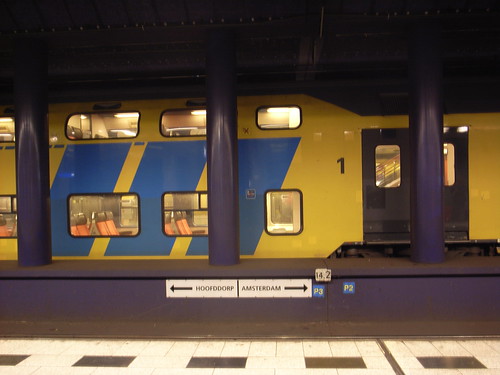 Some random notes from Mobile Monday Amsterdam, where I was invited last monday (to give a talk about "what the hell happened to location-based games"). The event was more specifically about mobile gaming/entertainment:
Some random notes from Mobile Monday Amsterdam, where I was invited last monday (to give a talk about "what the hell happened to location-based games"). The event was more specifically about mobile gaming/entertainment:
- Jeroen Ellferich interestingly brought this intriguing question: would you differentiate an iphone from an ipodtouch? is a Nintendo DS a mobile game platform? what about eee pc?
- He also reported on the odd fact that the most downloaded games today are the same as 5 years ago: tetris, pacman, who want to be millionaire, monopoly here and now, bejeweled, showing how the field is not very innovative.
- To him, the dark side of the mobile industry have the following characteristics: flattening growth traditional developers and publishers on mobile in troubles, fragmentation and porting hell (450 phone models!), flawed vale chain and low rev shares, lack of innovation in past years
- BUT, he showed that there is some hope: iphone and android trigger mobile content revival, flat-free and connectivity become the norm, there is a business case for location-based games (!?), social networks and games are a "killer combo", touchscreen, tilt, compass are opportunities too
- Kamar Shah, formerly at Nokia, described how users are far from the dream of having a simple mobile entertainment platform (as simple as we had on TV). He showed how people are tired because of fragmentation (operators, services, partners), experience is generally shit, it does not work, people pay twice... and unfortunately bad meme spread faster
- Kamar also mentionned that people want to watch stuff, tv, high def, replicate their experience on the mobile: it's the platform and the content that will drive the revenue, not the hardware.
- His main point was that the consumer experience is based on 5 key elements: how to find, try, buy, manage and share:
- we should make content accessible (over the air, on device, off the portal, on the portal...), consumer choose afterwards and have different habits: "content is king, distribution is king kong"
- people need to be able to try: demo, free-trial (website, on the phone), engage consumers otherwise the top 3 games will still be tetris and pacman!
- you have to enable all payment and billing mechanisms (micropayments...)
- when you buy food, you put it in the fridge, where do you put mobile games? there's a need of storage and manage in an easy place; apple does that really well: they have a marketplace where to go
- sharing content for free: it has to work, if you like sth, you'd like to pass it on, you should be able to send it via email, bluetooth...
- Redefining the consumer experience implies taking care of these 5 issues.
- He concluded that the financial crisis will have important consequences: people loose their job, can't pay the rent, how will they find the money to buy games? what's gonna happen? Kamar said that (1) people will have more time, (2) consumer demand will go down, people will learn what to do with what they have (the complexity of mobile phones), will educate themselves. It's good for our industry, because it's expensive for the industry to educate consumers. They will do it by themselves, (3) we will be able to take our technology right (and it takes time)
Thanks Yuri van Geest and Maarten Lens-FitzGerald for the invitation!
Vending machine interface design
 The evolution of vending machine interfaces is highly curious. Seen in Amsterdam yesterday, at the train station in Schiphol. This train ticket machine sports weird spikes. What do they mean? What are they intended to do? preventing people to put stickers? Or it can be a way to prevent credit card skimming (the practice of retrieving and using the information that is encoded on the magnetic strip of a legitimate credit card).
The evolution of vending machine interfaces is highly curious. Seen in Amsterdam yesterday, at the train station in Schiphol. This train ticket machine sports weird spikes. What do they mean? What are they intended to do? preventing people to put stickers? Or it can be a way to prevent credit card skimming (the practice of retrieving and using the information that is encoded on the magnetic strip of a legitimate credit card).
The way they are place on the interface is very odd. Any clue?
Augmented meeting point
 An interesting cluster of services at Schiphol airport near Amsterdam. This meeting point is enriched with:
An interesting cluster of services at Schiphol airport near Amsterdam. This meeting point is enriched with:
- A physical whiteboard so that people can leave messages, notes and writes stuff.
- A dual screen that: (a) explains how to send SMS messages, (b) list the different messages that people sent with their mobile phone. You can send messages to greet people and tell them you're arriving (or simply to take a certain transport mean).
Why do I blog this? It's interesting that both media (physical and electronical whiteboard) are present. Each of them have their own values (the physical one is available in case of power failure or if the tv screen is our of order) and allows a sort of presence mediated by different characteristics of the artifacts employed.
I also find relevant to observe how cluster of services are deployed in physical space, see also here.
Electricity and decay
 Seen in Guadeloupe last month. Made me think about this quote:
Seen in Guadeloupe last month. Made me think about this quote:
“The world constantly decays. Moisture gets in. Damp hangs around. Ice expands joints. Surfaces wear thin. Particles fall out of suspension. Materials rot. Insects breed. Animals chew. All kinds of wildlife war with all kinds of fabric. Humans make errors. Each process of dilapidation does its special harm and releases new ‘wastes’"
Graham S. and Thrift, N. (2007). Out of order, Theory, Culture & Society, Vol. 24, No. 3.



